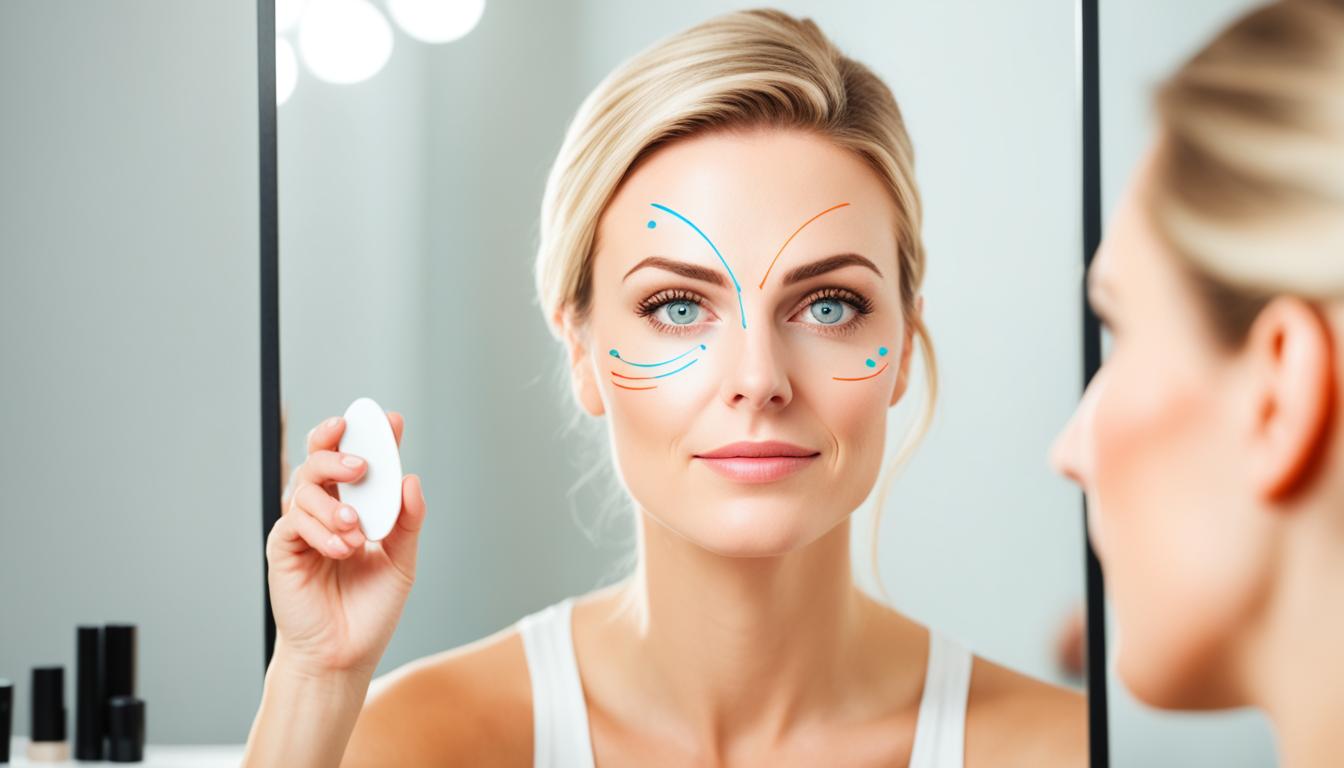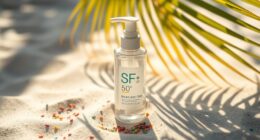To use glycolic acid for clearer skin, start with a product containing 4% or less. Apply it in the evening after cleansing, and layer with a hydrating moisturizer. Begin by using it 2-3 times a week and gradually increase if your skin tolerates it well. Always use sunscreen during the day, as glycolic acid can make your skin more sensitive. Keep exploring for tips on product choices and specific routines to achieve your skincare goals.
Key Takeaways
- Start with a low concentration glycolic acid product (less than 4%) to minimize irritation and gauge skin tolerance.
- Use glycolic acid products in the evening after cleansing to maximize exfoliation and skin rejuvenation overnight.
- Incorporate a hydrating moisturizer after applying glycolic acid to prevent dryness and maintain skin hydration.
- Gradually increase usage to 2-3 times a week, monitoring skin's response before transitioning to daily application if tolerated.
- Always apply sunscreen with at least SPF 30 during the day to protect against increased sun sensitivity.
What Is Glycolic Acid?

Glycolic acid, a powerful alpha-hydroxy acid (AHA) derived from sugarcane, is a key ingredient in many skincare routines. Known for its effective exfoliating properties, glycolic acid has the smallest molecular size among AHAs, allowing it to penetrate deeply into your skin. This penetration promotes cell turnover by dissolving the bonds between dead skin cells, making it easier for your skin to shed them. By clearing pores, glycolic acid helps prevent breakouts and stimulates collagen production, improving your skin texture while reducing the appearance of fine lines and wrinkles. Additionally, essential oils for hair growth can support overall skin health when used in conjunction with glycolic acid. You'll find glycolic acid in a variety of products, including cleansers, toners, serums, and chemical peels, suitable for both at-home and professional use. Additionally, incorporating essential oils into your skincare routine can enhance overall skin health and provide added benefits.
Benefits of Glycolic Acid for the Skin

Revealing clearer, healthier skin is achievable with the benefits of glycolic acid. This powerful alpha-hydroxy acid exfoliates by dissolving bonds between dead skin cells, showcasing a smoother complexion. It also boosts collagen production, reducing fine lines and enhancing skin firmness. Regular use improves skin tone by fading dark spots and hyperpigmentation, promoting an even appearance. Glycolic acid is also known to reduce the buildup of dead skin cells, which helps in achieving a more radiant look. Additionally, it can be beneficial to incorporate essential oils known for their skin-enhancing properties for a holistic approach to skincare.
| Benefits | Description |
|---|---|
| Exfoliation | Removes dead skin cells for a brighter look. |
| Collagen Production | Reduces fine lines, enhancing firmness. |
| Deep Penetration | Clears clogged pores, preventing breakouts. |
Glycolic acid's humectant properties attract moisture, ensuring hydration and a radiant finish. Experience these benefits for clearer skin!
Choosing the Right Glycolic Acid Product

When you're ready to incorporate glycolic acid into your skincare routine, selecting the right product is crucial for achieving the best results.
Start by considering the concentration of glycolic acid products. If you're a beginner, opt for lighter formulations with less than 4%. For experienced users, concentrations between 4% and 10% can effectively target specific skin concerns. It's also important to note that using products with antimicrobial properties can enhance overall skin health.
Aim for products with a pH level between 3 and 4 for ideal exfoliation without irritation. Exfoliating toners and cleansers are excellent starting points, while serums with higher concentrations (8%-10%) are perfect for treating fine lines or acne scars.
Always check the ingredient list to verify it includes hydrating components like hyaluronic acid or aloe vera to mitigate any potential dryness. Regular use of glycolic acid products is linked to improved skin texture and radiance.
How to Incorporate Glycolic Acid Into Your Skincare Routine

To effectively incorporate glycolic acid into your skincare routine, apply it in the evening after cleansing to maximize its benefits overnight. Layer it with a hydrating moisturizer to keep your skin nourished and prevent dryness. This combination will help you achieve a smoother, brighter complexion while minimizing irritation. Regularly monitoring your skin's response can also help you manage production quantity variance in your skincare regimen. Additionally, engaging in mindfulness through unplugging from technology can enhance your overall well-being, complementing your skincare efforts.
Evening Application Tips
Incorporating glycolic acid into your evening skincare routine can markedly enhance your skin's clarity and texture.
Start with a low concentration of glycolic acid, around 4% to 6%, and apply it 2-3 times a week. Cleansing your skin thoroughly before application is essential, as it helps improve absorption and effectiveness. Regular use of glycolic acid can also help with dandruff and scalp irritation, promoting overall scalp health.
After using glycolic acid, follow up with a hydrating moisturizer to prevent dryness and maintain skin hydration. Be mindful of your skin's tolerance; gradually increase the frequency as needed.
Finally, always remember to apply sunscreen with at least SPF 30 during the day to protect your skin from UV damage, especially after using glycolic acid at night. This approach promotes healthier, clearer skin over time. Additionally, pairing glycolic acid with hydrating ingredients can enhance its effectiveness and minimize irritation.
Layering With Moisturizer
Layering a moisturizer after applying glycolic acid is vital for maintaining hydration and enhancing your skin's overall appearance.
Always apply glycolic acid products in the evening after cleansing to optimize skin renewal overnight. This helps minimize sun sensitivity, but it can also lead to dryness.
To counteract this, choose a moisturizer that contains hydrating ingredients like hyaluronic acid or aloe vera. These ingredients boost moisture and soothe your skin post-exfoliation.
Start with lower concentrations of glycolic acid and gradually increase frequency as your skin builds tolerance. Monitor how your skin reacts and adjust your moisturizer application accordingly.
This way, you guarantee it complements your glycolic acid use without causing excess irritation, keeping your skin clear and radiant.
Tips for Safe Use of Glycolic Acid

Before you start using glycolic acid, it's vital to perform a patch test to guarantee your skin won't react negatively.
You should also introduce it gradually, starting with lower concentrations to help your skin adjust.
Finally, don't forget to apply sunscreen daily, as glycolic acid can increase your skin's sensitivity to the sun.
Patch Test Importance
Why is a patch test essential when trying out glycolic acid? Performing a patch test helps you identify potential irritation before applying the product to your face. Apply a small amount to an inconspicuous area, like your wrist, and wait 24 to 48 hours to monitor your skin's tolerance. If you notice any redness or discomfort, it's best to discontinue use and consult a dermatologist. Always start with a low concentration (below 4%) during the test to gauge how your skin reacts.
| Reaction Type | Description | Action |
|---|---|---|
| No Reaction | Skin remains unchanged | Safe to use on the face |
| Mild Irritation | Slight redness or discomfort | Consider lowering concentration |
| Moderate Irritation | Noticeable redness or swelling | Discontinue use and consult a dermatologist |
| Severe Irritation | Intense pain or severe rash | Stop immediately and seek professional help |
| Document Reaction | Keep notes on your skin's response | Helps inform future product choices |
Gradual Introduction Strategy
To effectively incorporate glycolic acid into your skincare routine, start slowly and allow your skin time to adjust.
Begin with a low concentration of glycolic acid, ideally less than 4%. Introduce it 2-3 times a week, and if your skin type responds well, gradually increase usage to daily.
Always perform a patch test on a small area to check for adverse reactions before applying it to your entire face.
After applying glycolic acid, follow up with a hydrating moisturizer to combat dryness and irritation, common during the initial phase.
This gradual introduction strategy helps your skin acclimate safely, minimizing potential side effects while maximizing the benefits of glycolic acid for clearer skin.
Consistent Sunscreen Application
After introducing glycolic acid into your skincare routine, maintaining consistent sunscreen application becomes essential.
Glycolic acid increases your skin's sensitivity to UV rays, making it more vulnerable to sun damage. To protect your skin effectively, choose a broad-spectrum sunscreen with at least SPF 30.
Apply it daily, even on cloudy days, since UV rays can still penetrate through the clouds. Remember to reapply every two hours when you're outside, especially if you're sweating or swimming.
Incorporating sunscreen into your morning routine not only shields your skin from harmful rays but also helps prevent irritation and photodamage linked to the exfoliating effects of glycolic acid.
Prioritize this step for healthier, clearer skin.
Common Skin Types That Benefit From Glycolic Acid

Glycolic acid can be a game-changer for various skin types, especially when you're seeking clearer, healthier skin.
If you have oily skin, glycolic acid helps regulate sebum production, minimizing breakouts and enlarged pores.
For dry or combination skin, it acts as a humectant, drawing in moisture while gently exfoliating dead skin cells for a smoother texture.
Mature skin also benefits, as glycolic acid stimulates collagen production, reducing fine lines and improving elasticity.
Acne-prone skin types see significant improvements, thanks to its ability to clear clogged pores and prevent future breakouts.
Even those with normal skin can enjoy the perks, using glycolic acid to enhance cell turnover and promote an even skin tone for a radiant complexion.
Potential Side Effects of Glycolic Acid

While glycolic acid offers many benefits for clearer skin, it can also lead to some potential side effects that you should be aware of. You might experience mild irritation, redness, or peeling, especially when you first incorporate it into your routine.
If you have sensitive skin, the irritation could be more pronounced. It's essential to perform a patch test before applying it widely.
Additionally, using glycolic acid in concentrations above 10% can heighten these side effects, leading to severe redness or peeling.
To prevent increased skin sensitivity, make sure to wear sunscreen daily. If you encounter persistent irritation, don't hesitate to discontinue use and consult a dermatologist for personalized advice and alternative treatment options.
Recommended Glycolic Acid Products

Finding the right glycolic acid products can greatly enhance your skincare routine while addressing any concerns about irritation. Here's a selection of effective options tailored to improve your skin texture:
| Product | Description |
|---|---|
| Exfoliating Toner (8% Glycolic Acid) | Daily use for smoother complexion and breakout control. |
| Exfoliating Serum (10% Glycolic Acid) | Apply 3-4 drops in the evening for targeted treatment. |
| Anti-Blemish Body Wash (6% Glycolic Acid) | Cleanses and clears pores, perfect for acne-prone skin. |
| Exfoliating Night Cream (6% AHA) | Nourishes overnight, promoting hydration and cell turnover. |
These glycolic acid products can help you achieve clearer skin while refining your skin texture.
Frequently Asked Questions
Does Glycolic Acid Make Your Skin Clear?
Yes, glycolic acid can make your skin clearer.
It exfoliates dead skin cells, prevents clogged pores, and promotes cellular turnover, revealing fresher skin. Regular use helps reduce hyperpigmentation and dark spots, leading to a more even complexion.
You'll also notice improvements in skin texture and a reduction in acne scars over time.
Just remember to use it consistently for the best results, and always follow up with sunscreen to protect your newly clear skin.
How Do You Use Glycolic Acid for Best Results?
Using glycolic acid is like revealing your skin's secret weapon!
Start with a low concentration, around 4%, to see how your skin reacts. Incorporate it into your nighttime routine, applying it after cleansing. Aim for 2-3 times a week initially, then up the frequency as tolerated.
Always follow with a moisturizer and don't forget sunscreen during the day. Keep an eye on any irritation, and adjust your usage accordingly for best results!
Is Glycolic Acid Better on Wet or Dry Skin?
Glycolic acid's effectiveness is best when applied to dry skin.
When you apply it on wet skin, you risk diluting the product, which can lead to uneven exfoliation.
To get the most out of glycolic acid, cleanse your skin thoroughly and wait a few minutes to guarantee it's completely dry.
This approach maximizes penetration and enhances the exfoliation of dead skin cells, giving you clearer, healthier skin over time.
What Not to Layer With Glycolic Acid?
Imagine your skin as a delicate garden. To keep it thriving, you wouldn't layer incompatible plants together, right?
Similarly, avoid mixing glycolic acid with other exfoliants like salicylic acid or retinoids, as they can overwhelm your skin. Steer clear of high vitamin C concentrations and alcohol-based toners, too; they disrupt your garden's harmony.
Always consult a dermatologist to craft a balanced skincare routine, ensuring your garden flourishes without irritation or dryness.
Conclusion
Incorporating glycolic acid into your skincare routine can transform your complexion like a magic wand, revealing clearer, smoother skin. By understanding its benefits and how to use it safely, you can unveil the secret to radiant skin. Remember to choose the right product for your skin type and start slowly to avoid irritation. With consistent use, you'll be well on your way to achieving the luminous glow you've always dreamed of! Embrace the journey to vibrant skin today!










